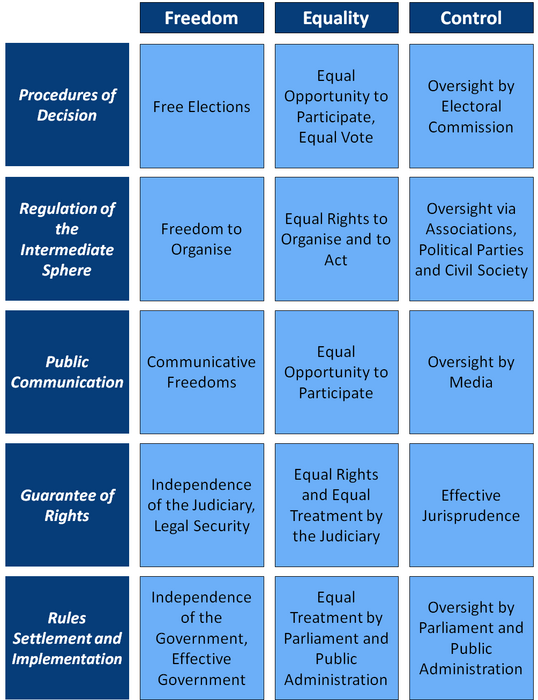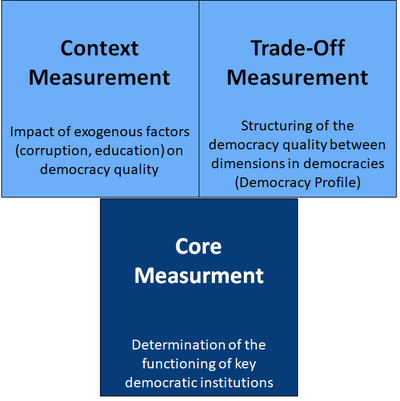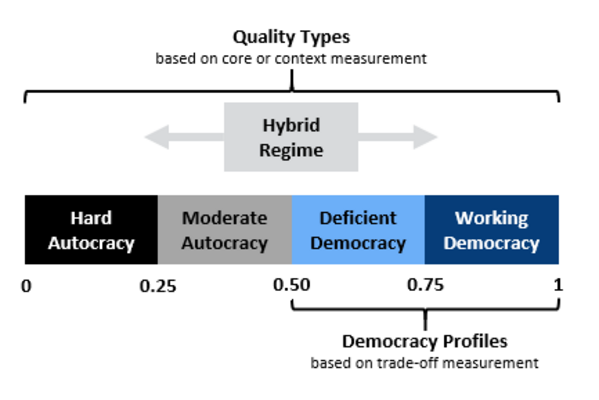The democracy matrix is a measurement tool for determining the democracy quality of countries worldwide and covers the period from 1900 to 2022 (as of February 2024). The following is intended to provide a brief overview of the democracy matrix; a more detailed description of the concept of the democracy matrix, on the other hand, is to be found here.
3 Dimensions
The democracy matrix draws its strength in large part from comprehensive democracy theoretical reflection and firm anchoring in the current state of research. This understanding of democracy comprises the dimensions of political freedom, political equality, and political and legal control. Whereas political freedom offers the opportunity to take part in the political process without restriction, and thus represents an active component, political equality is conceived “in the sense of equal treatment as a passive component”. Control, in turn, is chiefly directed toward the holders of government. Legal control takes place within a legal and constitutional framework, whereas political control is oriented toward softer criteria like efficiency and political objectives.
5 Institutions
From the point of view of democracy theory, five institutions can be distinguished that are key for the determination of democracy quality and that are hence studied by the democracy matrix. In the case of the institution of Procedures of decision, the focus is on the democratic quality of elections. Regulation of the intermediate sphere studies the functioning of the interest aggregation and articulation of political parties, interest groups and civil society. Public communication analyses the democracy quality of, on the one hand, the public communicative space and, on the other, the media. Guarantee of rights, furthermore, comprises the investigation of the courts and the rule of law. Finally, in the last institution, Rules settlement and implementation, the focus is placed on the democratic level of development of the government or the parliament, as well as the separation of powers in the political system itself.
15 Matrixfelder
The dimensions of freedom, equality and control can be combined with the five institutions procedures of decision, regulation of the intermediate sphere, public communication, guarantee of rights, and rules settlement and implementation, so that 15 matrix fields come into being, which are relevant for the investigation of democracy quality and which are analysed by the democracy matrix. A description of the components and subcomponents of the individual matrix fields in the form of concept trees is here.
3 Levels of Measurement
In addition, the democracy matrix offers three different levels of measurement, which provide distinct perspectives on the democracy quality of a country: pure core measurement, context measurement and trade-off measurement. Core measurement only deals with the functioning of key democratic institutions and represents the initial measurement. Context measurement goes beyond these characteristics and considers the embedding of these democratic institutions in socio-cultural contexts that undermine their operation. Thus, corruption in the executive and legislative branches leads not only to a perversion of decision-making processes, but also to distortions in the implementation of laws and justice. Finally, conflicting democratic goals are taken up using trade-off measurement. The dimensions of freedom, equality and control cannot all be simultaneously maximised in the sense of a perfect democracy, but rather democratic systems are faced with deciding to which of these dimensions they would like to give priority at the expense of other dimensions. Thus, we can distinguish between libertarian, egalitarian and control-focused democracies.
Quality Types and Democracy Profiles
Whereas core measurement and context measurement get reflected in quality types, trade-off measurement allows us for the first time to create democracy profiles.
Quality types can be depicted along a regime continuum, at the extremes of which hard autocracies and working democracies are to be found. Working democracies, on the other hand, exhibit a high degree of democratic development of both the dimensions and the institutions. In addition, in order to be able also meaningfully to classify political systems that occupy the border area between these two regimes, hybrid regimes and deficient democracies are distinguished. Deficient democracies are situated in the area of democracies, but they exhibit deficits in certain dimensions and/or institutions, such that they can no longer be regarded as working democracies. In contrast, hard autocracies are characterised by the fact that development of the dimensions and functionality of the democratic institutions are not present. Citizens possess neither rights to freedom nor to equality, and they are also unable to exercise any effective control vis-à-vis those who govern. Moderate autocratic regimes are characterised by a certain degree of liberalisation, which, however, on the whole remains rooted in the autocratic functional logic. Hybrid regimes, on the other hand, possess both autocratic and democratic dimensions or, respectively, institutions, and they thus combine conflicting regime forms.
Finally, using the trade-off level of measurement, the democracy matrix is able to measure democracy profiles. With regard to the dimensions, libertarian, egalitarian and control-focused democracies can be conceptually distinguished.
A Long Time-Series, Many Countries
Measurement is based on a targeted selection of data from the Varieties-of-Democracy-Project (V-Dem), which is what makes possible the great empirical range of the measurement tool. V-Dem offers an enormous wealth of different indicators, which the democracy matrix uses to depict essential components and subcomponents of democracy quality. Moreover, the collected data covers a long time period from 1900 to (for the moment) 2022 for approximately 200 countries. The assignment of the V-Dem indicators to the components and subcomponents of the individual matrix fields is found here. The scale value 0 corresponds to an autocratic system; the value 1, to a fully working democracy.
More Well-Founded in Democracy Theory, More Disaggregated and Differentiated
The democracy matrix is based on a conception of democracy with strong grounding in democratic theory, which is neither – as is the case for other tools for measuring democracy – too minimalist nor too maximalist. As compared to other measurement tools, which, for the most part, are only able to make transformation processes visible on a coarsely aggregated level, the distinguishing of 15 matrix fields, resulting from the combination of the five key democratic institutions and three dimensions, as well as three levels of measurement, allow for highly disaggregated and differentiated measurement of democracy quality. At the same time, the long time period guarantees that the change of deficits in individual sub-areas of democracy can be observed. Finally, thanks to the involvement of trade-offs. Besides the five quality types, for the first time democracy profiles become visible.




